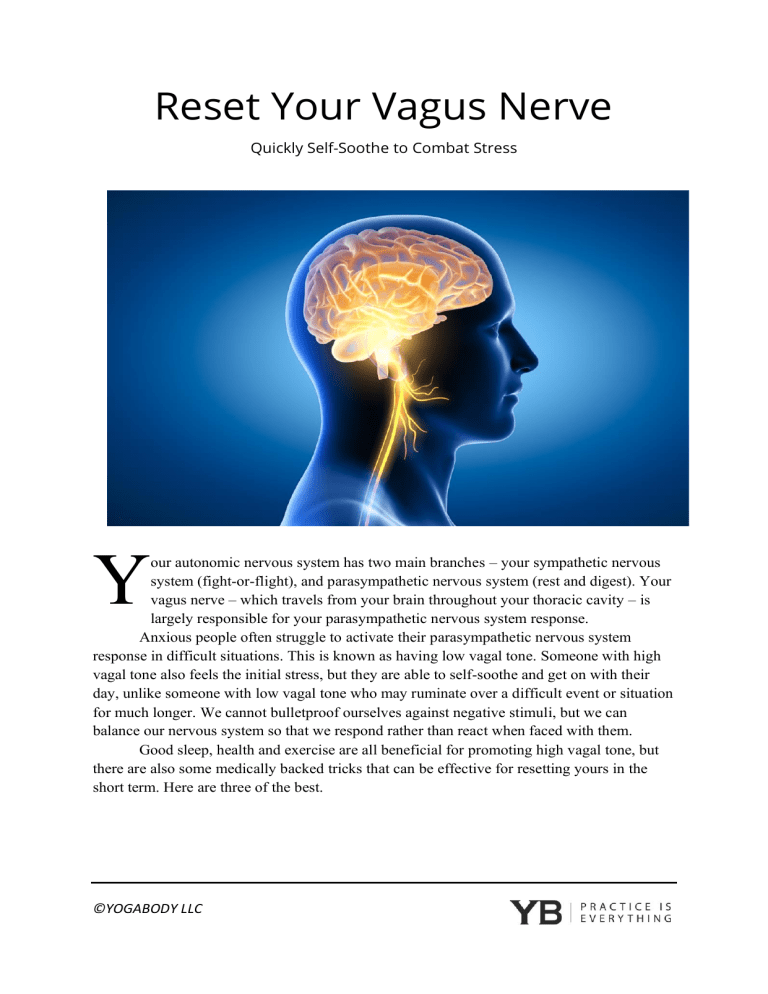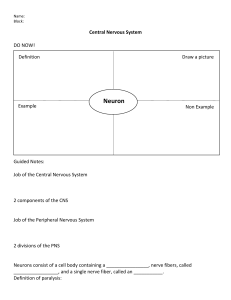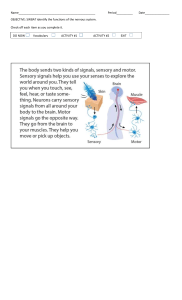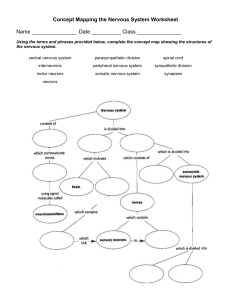
Reset Your Vagus Nerve Quickly Self-Soothe to Combat Stress Y our autonomic nervous system has two main branches – your sympathetic nervous system (fight-or-flight), and parasympathetic nervous system (rest and digest). Your vagus nerve – which travels from your brain throughout your thoracic cavity – is largely responsible for your parasympathetic nervous system response. Anxious people often struggle to activate their parasympathetic nervous system response in difficult situations. This is known as having low vagal tone. Someone with high vagal tone also feels the initial stress, but they are able to self-soothe and get on with their day, unlike someone with low vagal tone who may ruminate over a difficult event or situation for much longer. We cannot bulletproof ourselves against negative stimuli, but we can balance our nervous system so that we respond rather than react when faced with them. Good sleep, health and exercise are all beneficial for promoting high vagal tone, but there are also some medically backed tricks that can be effective for resetting yours in the short term. Here are three of the best. ©YOGABODY LLC COLD THERAPY When the protagonist of a Hollywood film hides in the bathroom to wash his face with cold water before a pivotal moment, this is not just movie drama. Water on your face, cheeks, and particularly your neck, triggers the mammalian dive reflex. While the mechanisms of action are not fully known, the effects are clear: reduced heart rate, increased heart rate variability, and a vagus nerve reset. An ice pack is more effective than water and if you place it on your neck, it delivers the best results. • Press an ice pack to the side of your neck for 15 seconds • Switch sides and repeat at least twice on either side • Practice this anytime you need to self-soothe, many students find this to be an effective pre-bed ritual SAFETY DISCLAIMER - some of these exercises will change your blood pressure and pulse. If you have high blood pressure, heart disease, or glaucoma, check with your doctor before practice. ©YOGABODY LLC MODIFIED VALSALVA MANEUVER The Valsalva Maneuver is used in emergency medicine to treat tachycardia (racing heart rate), and you can use it to quickly reset your vagus nerve. This practice initially increases your intrathoracic and intra-abdominal pressure, then reduces is, and the shift in pressure affects your cardiac output—and this chain of events stimulates your vagus nerve. It’s helpful to think of this as a forced reboot of your nervous system. • Inhale deeply, close your mouth and nose, bear down in a faux exhale as you press outward for 15 seconds • After 15 seconds, breathe through your nose, elevate your legs to 45 degrees and relax • Repeat this exercise up to four times ©YOGABODY LLC BALLOON BREATHING This is a very simple, gentler version of the modified Valsalva Maneuver and can be done more discreetly—and is even one that kids will enjoy. By filling the balloon and holding the pressure, you increase your abdominal and intra-thoracic pressure as well, again creating a reset effect. You’ll need a balloon and timer for practice. • Blow to inflate the balloon and hold for 15 seconds • Release and pause for 30 seconds • Repeat up to four times – 15 seconds on, 30 seconds off • If you feel dizzy at all, take a break ©YOGABODY LLC More from YOGABODY YOGABODY is a leader in science-based yoga classes and professional training courses with over 23,000 teachers in 41 countries. Founded by Lucas Rockwood in 2006, YOGABODY publishes weekly educational content for students and teachers alike. Find links to helpful resources below. • • • • ©YOGABODY LLC Subscribe to YouTube videos Lucas’ Teaching / Course Schedule Weekly Podcast YOGABODY Store




